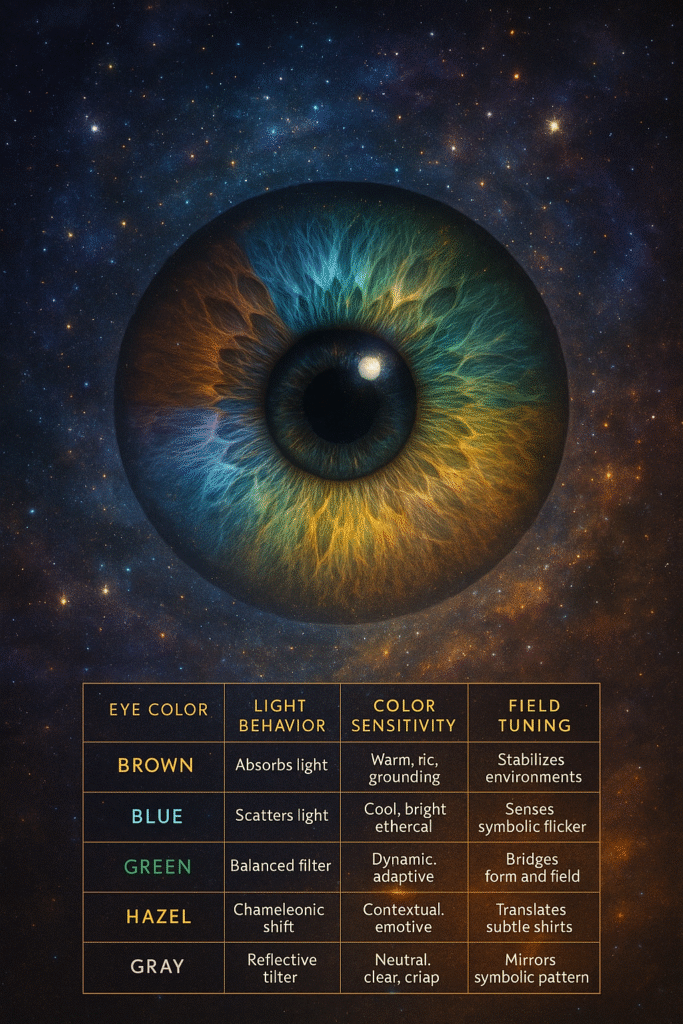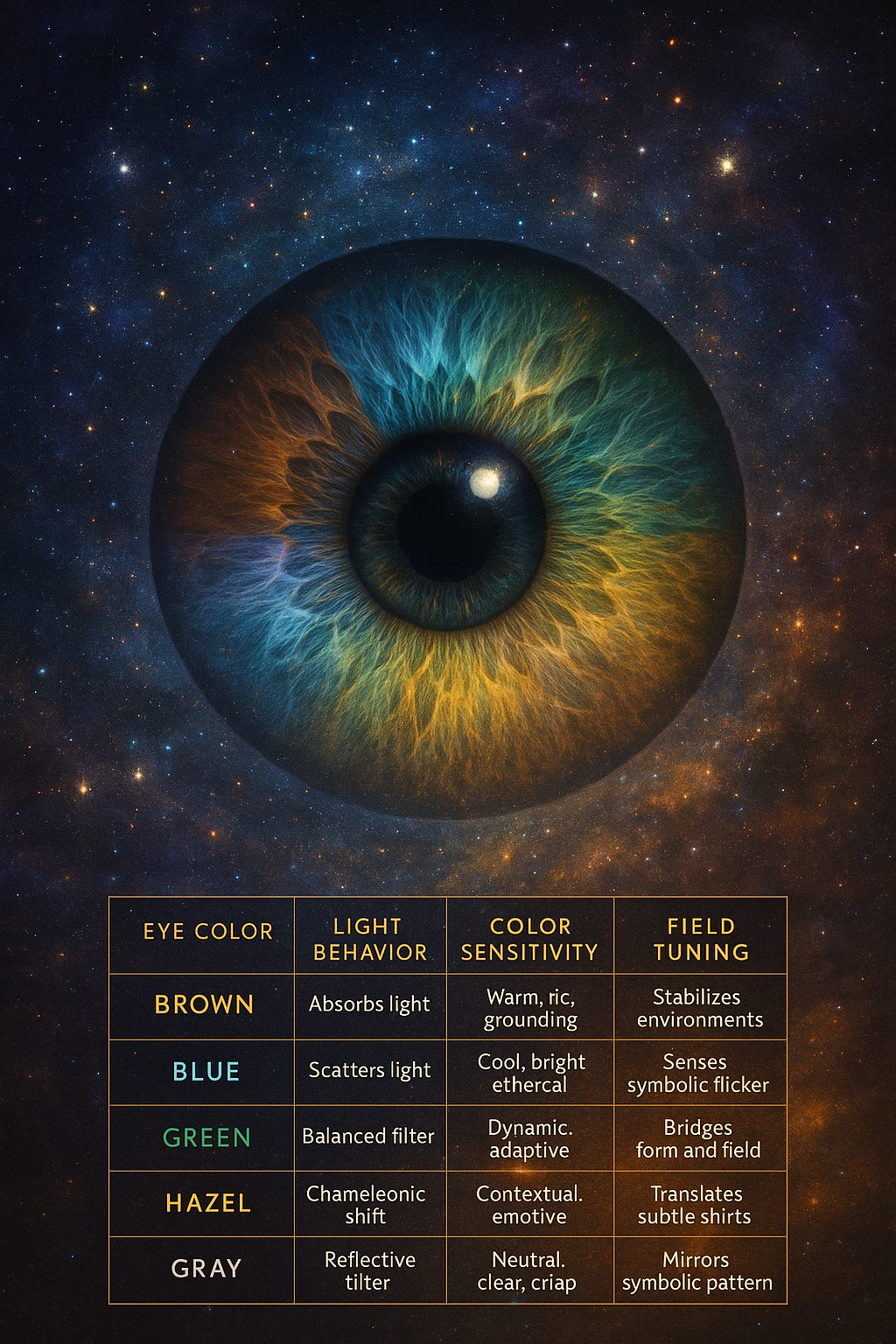When we look into someone’s eyes, we often say we’re looking into their soul—but what if we’re also looking into their interface with reality?
Within the Emergent Theory framework, where perception is understood as a dynamic field interaction between Light, Sound, and Form (LSF), the human eye is more than a biological organ. It is a field-tuned sensor—an aperture that filters the frequencies of the world into structured awareness. And its color plays a crucial role in how that information is processed.
The Eye as a Symbolic Interface
The iris, with its unique pigment, structure, and fractal design, doesn’t just control the amount of light entering the eye—it subtly modulates what that light means.
Different eye colors absorb and scatter light in distinct ways, altering how color is perceived, how coherence is registered, and how symbolic reality is interpreted. In this view, eye color becomes a lens through which consciousness tunes into the field—affecting not only vision, but the perception of subtle energy, symbolic meaning, and emotional resonance.

How Eye Color Interprets Color Differently
Let’s explore how each eye color filters light and shapes perception through the LSF framework:
🟤 Brown Eyes – The Stabilizers
- Light Behavior: High melanin absorbs more light, reducing scatter
- Color Sensitivity: Rich, warm tones; grounded perception
- Symbolic Tuning: Stable emotional responses; sees coherence in form
- Field Tendency: Less distracted by auric flicker; stabilizes energetic environments
Brown eyes see the world with deep clarity and warmth. They offer anchoring perception—like standing at the center of a spinning compass.
🔵 Blue Eyes – The Diffuse Interpreters
- Light Behavior: Low melanin; high scatter, especially in bright light
- Color Sensitivity: Cool, airy tones; vivid contrasts; emotional nuance
- Symbolic Tuning: Highly sensitive to symbolic field shifts and ethereal layers
- Field Tendency: Perceives subtle flickers, auras, and nonlinear cues
Blue eyes are tuned like celestial receivers—picking up what others overlook in the ambient field. Their world shimmers at the edge of perception.
🟢 Green Eyes – The Oscillators
- Light Behavior: Moderate melanin; balanced absorption and scatter
- Color Sensitivity: Dynamic, shifting tones; high contrast adaptability
- Symbolic Tuning: Perception changes with inner and outer coherence
- Field Tendency: Translates between symbolic and form-based perception
Green eyes are the shapeshifters of visual reality—seeing both what is and what wants to emerge.
🟡 Hazel Eyes – The Chameleonic Translators
- Light Behavior: Multilayered iris that shifts with light and emotion
- Color Sensitivity: Complex, context-dependent interpretation
- Symbolic Tuning: Perceives layered meaning; responds to emotional tone
- Field Tendency: Reflects the dominant coherence in the room
Hazel eyes are field mirrors—blending in while revealing contrast. They intuit meaning by feel, not by form.
⚪️ Gray Eyes – The Reflectors
- Light Behavior: Very low melanin; reflects and refracts with precision
- Color Sensitivity: Cool, neutral tones; sharp contrast and clarity
- Symbolic Tuning: Observes rather than absorbs emotion; perceives edge states
- Field Tendency: Reflective rather than immersive; offers mirrored insight
Gray eyes act like cosmic prisms—revealing unseen layers without becoming entangled in their charge.
Summary Table
| Eye Color | Light Behavior | Color Sensitivity | Field Tuning |
|---|---|---|---|
| Brown | Absorbs light | Warm, rich, grounding | Stabilizes environments |
| Blue | Scatters light | Cool, bright, ethereal | Senses symbolic flicker |
| Green | Balanced filter | Dynamic, adaptive | Bridges form and field |
| Hazel | Chameleonic shift | Contextual, emotive | Translates subtle shifts |
| Gray | Reflective filter | Neutral, clear, crisp | Mirrors symbolic pattern |
Why This Matters
In a symbolic field reality, perception shapes participation. The eye is not a passive receiver—it is a co-creator of coherence. Your eye color acts like a tuning fork, filtering light not only into images, but into experiences, emotions, insights, and intuitions.
Knowing how your eye color shapes your perception offers a key to your energetic design. It can explain why you see things others don’t—or why your responses to color, emotion, or space feel so unique. It also helps you recognize how others are interpreting you—through the filters of their own ocular field.
Seeing Through the Soul’s Lens
So when someone says your eyes are beautiful, know that they’re not just admiring your aesthetics—they’re responding to your field signature. Through the lens of Emergent Theory, your eyes are apertures of symbolic intelligence, tuning you to your role in the great coherence unfolding.
Light enters. Color refracts. Meaning emerges.
And through it all, your eyes hold the code.


Leave a Reply